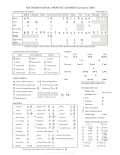the distinction, alveolars and dentals are typically called taps and other articulations flaps. No language contrasts a tap and a flap at the same place...
24 KB (1,415 words) - 07:18, 15 October 2024
for some speakers, and Kamviri, which also has apical alveolar taps and flaps. The tap and flap consonants identified by the International Phonetic Alphabet...
15 KB (1,673 words) - 20:16, 21 October 2024
Trill consonant (redirect from Voiced labiodental trill)
Alphabet: [r] – Voiced alveolar trill [r̥] – Voiceless alveolar trill [ʙ] – Voiced bilabial trill [ʙ̥] – Voiceless bilabial trill [ɽ͡r] – Voiced retroflex trill...
11 KB (1,145 words) - 14:13, 25 October 2024
International Phonetic Alphabet (category Official website different in Wikidata and Wikipedia)
flaps and taps are two different kinds of articulation, but since no language has (yet) been found to make a distinction between, say, an alveolar flap...
166 KB (16,108 words) - 05:49, 22 November 2024
Velar consonant (redirect from Voiced velar)
for the voiced alveolar lateral fricative, ⟨ɮ⟩, but also notes that the sound to be prevelar.) Donald J. Phillips (1976). Wahgi Phonology and Morphology...
14 KB (1,112 words) - 04:31, 22 November 2024
fricatives (and most often is so), unless it occurs single between vowels, being so realized as a dental, alveolar, postalveolar or retroflex flap. In the...
29 KB (3,459 words) - 02:08, 1 September 2024
just like "panning". In this case, both alveolar stops and alveolar nasal plus stop sequences become voiced taps after two vowels when the second vowel...
24 KB (2,873 words) - 17:21, 9 November 2024
of a dental stop or an alveolar stop, it will usually be laminal if it is a dental stop, and the stop will usually be apical if it is an alveolar stop...
40 KB (5,267 words) - 04:46, 21 March 2024
"utter" and the "dd" of "udder" are pronounced as a flap [ɾ] in North American and Australian English. Many linguists distinguish taps from flaps, but there...
14 KB (1,720 words) - 06:34, 22 May 2024
Approximant (category Pages with non-English text lacking appropriate markup and no ISO hint)
approximant [ð̼˕] (usually transcribed ⟨ð̼⟩) dental approximant [ð̞] (usually transcribed ⟨ð⟩) alveolar & post-alveolar approximant [ɹ] retroflex approximant...
29 KB (3,022 words) - 15:24, 11 November 2024
Phonetics (category Harv and Sfn no-target errors)
of a dental stop or an alveolar stop, it will usually be laminal if it is a dental stop, and the stop will usually be apical if it is an alveolar stop...
81 KB (10,586 words) - 05:36, 20 November 2024
stops into fricatives but also laterals and trills into weaker laterals and taps), and voiceless stops became voiced. For example, Indo-European intervocalic...
33 KB (3,063 words) - 11:47, 25 October 2024
realized as an alveolar approximant [ɹ] or even as a voiced apico-alveolar [ɹ̝], and it is quite common in inland Ecuador, Peru, most of Bolivia and in parts...
83 KB (9,834 words) - 23:29, 28 September 2024
full voice contrasts: /p b/, dental /t̪ d̪/, alveolar /t d/, the sibilants /s z/ (which have allophonic variation with [tʃ] and [dʒ] respectively) and velar...
70 KB (6,500 words) - 04:41, 22 November 2024
Bengali phonology (section Affricates and fricatives)
as a voiced alveolar flap [ɾ], voiced alveolar approximant [ɹ] or voiced alveolar trill [r]. Most speakers colloquially pronounce /r/ as a flap [ɾ], although...
29 KB (2,978 words) - 07:36, 17 October 2024
ladder are seldom realised as alveolar taps or flaps like in North American English and certain varieties of Australian and New Zealand English. However...
64 KB (6,720 words) - 16:20, 22 November 2024





